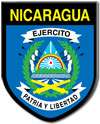Nicaraguan Air Force
The Nicaraguan Air Force continues the former Sandinista air units. Before 1979 the Nicaraguan National Guard had some air units ("Fuerza Aérea de la Guardia Nacional").
| Nicaraguan Air Force | |
|---|---|
| Fuerza Aérea Nicaragüense | |
 | |
| Founded | 1938 |
| Country | |
| Branch | Air Force |
| Size | 21 aircraft |
| Colors | Red, Black and yellow |
| Anniversaries | 1 February[1] |
| Insignia | |
| Roundel |  |
| Former roundel (1936-1980) |  |
| Aircraft flown | |
| Utility helicopter | Mi-17 |
| Trainer | Cessna 185, Cessna T-41D |
| Transport | Cessna 337, PA-28, AN-26 |
.jpg)
Air force
In 1920, the National Guard received from the United States its first four aircraft, four Curtiss JN-4.
In 1927 the first use of aircraft in combat took place in the country – on July 5 during the Battle of Ocotal five American Airco DH.4 aircraft attacked the forces of General Augusto Sandino.[2]
The "Nicaraguan National Guard Air Force" (Fuerza Aérea de la Guardia Nacional) was formed in 1938. From 1942 small numbers of trainers and transports were acquired from the United States and by 1945 a total of 20 aircraft were on strength. In 1952 a US aviation mission arrived and saw an increase of the numbers of trainers and transports delivered followed by combat aircraft such as the P-38, P-51 and P-47. For some years the Nicaraguan air force was the strongest in Central America but after the 1979 the civil war a most of its US trained pilots defected and thereafter much eastern bloc equipment was acquired.
When the Sandinistas assumed control in 1979, the Sandinista Air Force/Air Defense Force (Fuerza Aérea Sandinista/Defensa Anti-Aérea—FAS/DAA) inherited only the remnants of the National Guard's small air force. Equipment included a few AT-33A armed jet trainers, Cessna 337s, and some transports, trainers, and helicopters. The time required to train pilots and construct airfields precluded a rapid FAS/DAA buildup. Beginning in 1982, the Sandinistas received from Libya the Italian-made SF-260A trainer/tactical support aircraft and the Czechoslovakian Aero L-39 Albatros, a subsonic jet trainer that could be missile-armed for close-in air defense. In addition to light and medium transport aircraft, the air force acquired a fleet of helicopters from the Soviet Union that served as a vital asset in the war against the Contras. They included Mi-8 and Mi-17 transport helicopters and later the Mi-24, followed by its export variant, the Mi-25, a modern armored assault helicopter. After Humberto Ortega revealed that Nicaragua had approached France and the Soviet Union for Mirage M50 or MiG fighter planes, the United States warned against introducing modern combat jets to the region. Although Nicaragua began construction of a new airbase with a longer runway and protective revetments, it did not succeed in acquiring new fighter aircraft.
A series of radar sites were constructed to give the Sandinistas radar coverage over most of Nicaragua, with the added capability of monitoring aircraft movements in neighboring countries. A Soviet-designed early-warning/ground-control intercept facility gave the air force the potential to control its combat aircraft from command elements on the ground.
After 1990 the FAS/DAA was no longer able to maintain its full aircraft inventory without Soviet support. The personnel complement fell from 3,000 in 1990 to 1,200 in 1993. Airbases at Bluefields, Montelimar, Puerto Cabezas, Puerto Sandino, and Managua remained operational. Combat aircraft were reduced to a single mixed squadron of Cessna 337s, L-39s, and SF-260As. However, the serviceability of all these aircraft was doubtful. In 1992 a number of helicopters and six radar units were sold to Peru. A small fleet of helicopters, transports, and utility/training aircraft was retained. In 1996 the Nicaraguan air force changed its name from Fuerza Aérea Sandinista to the Fuerza Aérea Nicaragüense (FAN).
Ranks and insignia
Aircraft
Current inventory
| Aircraft | Origin | Type | Variant | Number | Notes | |
|---|---|---|---|---|---|---|
| Combat Aircraft | ||||||
| MiG-21 Fishbed | Russia | FGA | Mig-21 Bis/Mig-21U | 24 | Were based in Cuba. Out of service. | |
| AT-33A | USA | jet training/CAS | 4 | Out of service, 1979. | ||
| MiG-17 Fresco D | Russia | FGA | 15 | Out of service. | ||
| Ilyushin IL-28 Beagle | Russia | LB | 6 | Out of service (reported). | ||
| AT-28D Trojan | USA | training/COIN | AT-28A/D | 18 | retired | |
| Special Mission/ISTAR | ||||||
| Cessna 337 | USA | liaison | O-2A/B | 8 | 10 delivered | |
| Transport | ||||||
| C-47 Dakota | USA | Transport | 13 | retired | ||
| C-123K Provider | USA | Transport | 5 | |||
| DHC-4 Caribou | Canada | Transport | 3 | |||
| Fokker F-27 | Netherlands | VIP | 1 delivered | |||
| Cessna 401 Titan | USA | transport | 1 | |||
| Cessna 210 | USA | utility | 2 | |||
| Antonov An-26 Curl | Russia | utility | An-26C Curl | 4 (7 delivered) | 2 on order | |
| Antonov An-2 Colt | Russia | utility | 11 delivered, but out of service | |||
| Helicopters | ||||||
| Mil Mi-17 | Russia | utility/attack | 48 | |||
| Mil Mi-8 | Russia | utility/attack | Mi-8 Hip-H | 15 | A total of 60 delivered. some sold to Peru (12 Mil Mi-8 Hip-E & 48 Mil Mi-17 Hip-H delivered). | |
| Mil Mi-25 | Russia | attack | Mil Mi-25 Hind-E | 28 (12 Mil Mi-25 Hind-E + 16 Mil Mi-24 Hind D) | ||
| Hughes OH-6A Defender | USA | Attack | 12 out of service | |||
| Mil Mi-2 Hoplite | Russia | attack | 3 (10 delivered) | |||
| Trainer Aircraft | ||||||
| SIAI SF-260W | Italy | liaison/light attack | 4 (6 deilvered) | |||
| Aero L-29 Delfín | Czechoslovakia | light attack | 1 out of service/reported | Was based in Cuba | ||
Retired aircraft
Previous aircraft operated by the Air Force consisted of the Boeing B-17, Consolidated PBY-5, Consolidated B-24, Douglas C-47, Grumman TBF and North American P-51 Mustang.
References
- https://anydayguide.com/calendar/1732
- А. М. Сериков. Никарагуа: солнце из огня. М., «Советская Россия», 1986. стр.12
| Wikimedia Commons has media related to Air force of Nicaragua. |
- World Aircraft Information files BrightStar publishing London File 342 Sheet 3